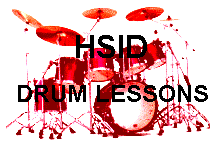Downloads *
Drummers Trivia *
Drummers Chat Rooms *
Rudiments *
Digital Music *
Knowledge Assessments *
TD Archives *
Drum Set Buyers Guide *
Bass-Player Jokes *
Assembling a Drum Set *
Parts of a Drum Set *
About HSID *
Video Troubleshooter
Bill Powelson's School of Drums
School of Drums
PRIVATE DRUM LESSON
"LATIN RHYTHMS: (Mambo)"
Copyright 1998 Bill Powelson all rights reserved


 This pattern will suffice
as a Mambo. Actually it is only half a Mambo beat, but it is the main half. You may
use it on most mambo tunes. Learn this simpler form in step one and be able to play it rapidly from memory. Then, take your time and graduate slowly into the more
complex versions (below.)
This pattern will suffice
as a Mambo. Actually it is only half a Mambo beat, but it is the main half. You may
use it on most mambo tunes. Learn this simpler form in step one and be able to play it rapidly from memory. Then, take your time and graduate slowly into the more
complex versions (below.)

 This is more like a true Mambo. It is the same as the beat above but now we are coming off
the snare to play two notes on the high, mounted (small) tom. Remember, you are using
a Layover Rimshot on the snare. This means
you will be using the butt of the stick to play the two tom notes.
This is more like a true Mambo. It is the same as the beat above but now we are coming off
the snare to play two notes on the high, mounted (small) tom. Remember, you are using
a Layover Rimshot on the snare. This means
you will be using the butt of the stick to play the two tom notes.

 Toss in a couple of extra bass drum notes. There are many ways to configure the bass, depending on your
on ability and the tempo of the song you may be playing.
Toss in a couple of extra bass drum notes. There are many ways to configure the bass, depending on your
on ability and the tempo of the song you may be playing.

 Classic Mambo with a simplified quarter note bass drum. Now we have turned this into a two-bar pattern
but it still sounds a lot like the one-bar version. I intentionally omitted the hi-hat
notes from the above versions to keep things as simple as possible. You may want to
practice kicking the hi-hat along with all the backbeats later. Remember, your right hand is playing on either the cowbell or the bell of your ride cymbal.
Classic Mambo with a simplified quarter note bass drum. Now we have turned this into a two-bar pattern
but it still sounds a lot like the one-bar version. I intentionally omitted the hi-hat
notes from the above versions to keep things as simple as possible. You may want to
practice kicking the hi-hat along with all the backbeats later. Remember, your right hand is playing on either the cowbell or the bell of your ride cymbal.
 VIDEO: Click here to see, and hear the above pattern.
VIDEO: Click here to see, and hear the above pattern.

 Classic Mambo with a complex bass drum pattern. Good luck! It's a mind blower! You are now working
the hi-hat with your foot on the backbeats and playing double 8th note bass drum
notes all the way through the pattern. Train yourself at very slow tempos in the beginning. Take heart in the fact that if you can play this one as it is written,
you'll be at the top of the heap. This beat is for ultra heavy-weights only!
Classic Mambo with a complex bass drum pattern. Good luck! It's a mind blower! You are now working
the hi-hat with your foot on the backbeats and playing double 8th note bass drum
notes all the way through the pattern. Train yourself at very slow tempos in the beginning. Take heart in the fact that if you can play this one as it is written,
you'll be at the top of the heap. This beat is for ultra heavy-weights only!
ADDITIONAL THOUGHTS: All of the above patterns may be used as substitute
rhythms for cut-time 2/4 or very fast quarter-note 4/4, when playing extremely
up tempo songs that are not at all Latin. Sometimes, these beats can act as
life-savers on very long, cut-time 2/4 jams or jazz tunes. It is actually easier
to play the right-hand Mambo-style rhythms at a quicker pace than the steady
cymbal ride of cut-time 2/4. When jamming at extreme tempos in cut-time 2/4,
the right hand may become tired and begin to cramp during an especially
long tune. A wise drummer will convert the right-hand rhythm to a quasi-Mambo,
as a means to relax while maintaining those greuling tempos. The same may be said for
certain Calypso rhythms. Even the upcoming 'Merengue' beat pattern may also sometimes be adaptable to the same conversion.
The point I am making here is to say that even though you may not be expecting
to play an abundance of Latin style music . . . many of these Latin patterns are
commonly adapted to other musical styles by omitting the rimshots and additional
tom tom notes. They may be very usefully adapted as substitute rhythms for Cut-time
2/4, Quarter 4/4 and other common 'Pop' style dancebeats.

Copyright Bill Powelson 1996 all rights reserved.



